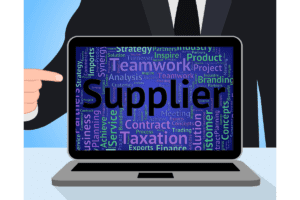How To Create A Successful Supplier Diversity Program: A Step-by-Step Guide

Are you looking to diversify your supply chain but unsure where to begin? A recent report indicates that businesses with diverse supplier networks tend to experience improved innovation and market growth. This blog post will guide you step-by-step on how to create a successful Supplier Diversity Program, aiding in the expansion of your procurement process. Ready for a more inclusive supply network? Let’s dive in!
Key Takeaways
- Determine the groups to include in your supplier diversity program, such as women, minorities, and small businesses. This step is crucial for success.
- Establish a policy that outlines the types of certifications you will accept from diverse suppliers. Offering support and advice can help small suppliers navigate this process.
- Define metrics to measure the success of your program, such as the number of diverse suppliers in your supply chain and the cost of goods purchased. Benchmarking with similar programs can provide goals for improvement.
- Identify organizations and industry groups to join that align with your program’s goals. These groups can offer valuable resources, support, and networking opportunities.
- Assign responsibility to key employees who have a clear understanding of the program’s goals and requirements. This ensures better coordination and communication among stakeholders involved in supplier diversity.
What is Supplier Diversity in Procurement / Supply Chain?
Supplier diversity is a proactive business strategy that prioritizes the inclusion of diverse-owned vendors in procurement processes. It emphasizes working with suppliers from various backgrounds, such as minorities, women, veterans, and LGBTQ+ communities, to foster innovation, economic growth, and social responsibility. By diversifying the supply chain, businesses not only promote inclusivity but also tap into a broader range of expertise and market insights.
Five Steps to Creating a Supplier Diversity Program

Determine the groups to include in the program, establish certification types accepted, define metrics for measuring program success, identify organizations and industry groups to join, and assign responsibility to key employees.
Determine the groups to include in the program
You need to pick the groups for your program. These groups could be women, minorities or small businesses. They may also be those who live in poor areas. Who you pick will set how your program works.
It is a big step in making a successful supplier diversity program.
Establish certification types accepted
The first step is to choose what kinds of certificates you will allow. This will be in a set policy for the supplier diversity program. Some suppliers are small and may have a tough time getting their certificate.
Certifications validate a business’s claim to a particular diversity status. Common certifications include Minority Business Enterprise (MBE), Women Business Enterprise (WBE), and Disabled Veteran Business Enterprise (DVBE). The certification process typically involves a thorough review of the business, including its ownership and operations, by a recognized third-party agency. Suppliers can approach local chambers of commerce or national councils dedicated to minority or women-owned businesses to begin the certification process.
You can help these diverse suppliers by giving support and advice. They can then get through the process better. Your business should make sure it has enough different types of certified suppliers.
It helps build a good supplier base for your procurement function.
Define metrics for measuring program success
You need to know if your supplier diversity program is a success. One way is to count the number of diverse suppliers in your supply chain. More diverse suppliers mean better results.
Another way is to look at the cost of goods and services from the program.
What’s also vital is benchmarking. You should compare your results with similar programs. This can give you goals for what you want to reach. Goals keep you on track and moving forward in building your successful supplier diversity program.
Identify organizations and industry groups to join
To create a successful supplier diversity program, it is important to identify organizations and industry groups to join. These groups can provide valuable resources, support, and networking opportunities for your program.
For example, you can consider joining the National Minority Supplier Development Council or local chambers of commerce that focus on minority-owned businesses. By being part of these organizations, you can connect with a diverse pool of potential suppliers and stay updated on best practices in supplier diversity.
Remember to choose organizations that align with your goals and objectives for your program.
Assign responsibility to key employees
To create a successful supplier diversity program, it is important to assign responsibility to key employees. These individuals should have a clear understanding of the program’s goals and requirements.
They should also possess the necessary knowledge and expertise to effectively implement and manage the program. By assigning responsibility, accountability is established, allowing for better coordination and communication among stakeholders involved in the supplier diversity program.
This ensures that the program runs smoothly and achieves its objectives.
Benefits of a Supplier Diversity Program

A supplier diversity program offers several benefits, including increased access to diverse suppliers, improved innovation and creativity, and an enhanced reputation and brand image.
Increased access to diverse suppliers
Supplier diversity programs offer businesses increased access to diverse suppliers, which can provide more sourcing options and promote inclusiveness. By engaging with a wide range of suppliers from different backgrounds, businesses can tap into their expertise and unique perspectives, leading to innovation and fresh ideas.
Additionally, supplier diversity certification is available to identify and promote businesses that actively participate in supplier diversity programs. This certification helps establish credibility and trust with diverse suppliers, making it easier for them to connect with potential business partners.
Moreover, implementing a supplier diversity program can also help businesses meet federal requirements and regulations related to supplier diversity.
Improved innovation and creativity
Supplier diversity programs are not only about promoting inclusion and fairness, but they also bring valuable benefits to businesses. One significant advantage is improved innovation and creativity.
By diversifying your supplier base, you open yourself up to a wide range of perspectives and ideas from different backgrounds and experiences. This fresh influx of viewpoints can lead to new insights, innovative solutions, and creative approaches that may not have been possible otherwise.
So by investing in supplier diversity, you’re not just supporting underrepresented groups – you’re also fostering a more dynamic and innovative business environment for your projects.
Enhanced reputation and brand image
Having a supplier diversity program can greatly enhance your company’s reputation and brand image. By actively seeking out and working with diverse suppliers, you show your commitment to inclusivity and equality.
This sends a positive message to your customers, partners, and employees that you value diversity and are dedicated to supporting underrepresented groups. Additionally, adding diverse suppliers to your supply chain fosters innovation and brings fresh perspectives into your organization.
This can lead to improved product quality, increased creativity, and ultimately enhance your brand image in the marketplace.
Best Practices for Implementing a Supplier Diversity Program
Implementing a supplier diversity program effectively involves making it a central part of the company strategy, gaining leadership buy-in, setting clear goals and objectives, expanding outreach efforts, and providing training and support for suppliers.
Make it a central part of company strategy
To build a successful supplier diversity program, it is important to make it a central part of your company’s strategy. This means integrating supplier diversity into your overall business plan and ensuring that it aligns with your organization’s goals and objectives.
By making supplier diversity a priority at the strategic level, you send a clear message to all stakeholders about the importance of diversity and inclusion in your procurement process.
Leadership buy-in is crucial for the success of a supplier diversity program, so make sure top management understands and supports this initiative.
Gain leadership buy-in
Gaining leadership buy-in is crucial for the success of a supplier diversity program. It means getting the support and commitment from top executives and decision-makers in your organization.
When leaders are on board, they provide the necessary resources and support needed for the program to thrive. To gain leadership buy-in, you need to communicate the benefits of a supplier diversity program, such as reducing costs and expanding the customer base.
Numerous studies indicate that companies with diverse suppliers often outperform their counterparts in innovation, market reach, and profitability. Highlighting case studies of successful companies with robust Supplier Diversity Programs can also be persuasive.
Setting clear goals for the program is also important in gaining their support. Additionally, involving various stakeholders and widening the reach of the program can help in gaining leadership buy-in.
Set clear goals and objectives
To create a successful supplier diversity program, it is important to set clear goals and objectives. This means having a clear policy that outlines what the program aims to achieve.
For example, the goals could include introducing diverse suppliers into the procurement process, reducing costs, and expanding the customer base. By setting clear goals and objectives, you can ensure that everyone involved in the program understands what needs to be achieved and can work towards those targets.
Expand outreach efforts
To build a successful supplier diversity program, it’s important to expand your outreach efforts. This means reaching out to a wider range of diverse suppliers and connecting with organizations and industry groups that focus on supplier diversity.
By attending supplier diversity events and joining networks like the Women’s Business Enterprise National Council, you can increase your chances of finding qualified and diverse suppliers.
Additionally, investing in training programs for these suppliers can help them meet your requirements and improve the quality of their products or services. Remember, expanding outreach efforts is crucial for promoting inclusivity in your procurement process and supporting small and diverse businesses.
Provide training and support for suppliers
To ensure the success of your supplier diversity program, it’s crucial to provide training and support for your suppliers. This means offering guidance and resources to help diverse suppliers navigate the certification process, understand your company’s procurement requirements, and meet your expectations.
Additionally, consider implementing a mentoring program where experienced suppliers can mentor new or smaller diverse businesses. By investing in their growth and development, you’re not only helping them succeed but also building a stronger and more inclusive supply chain.
Remember that providing ongoing training and support is essential for maintaining strong relationships with your diverse suppliers and ensuring the effectiveness of your supplier diversity program in the long run.
FAQs
1. What is a supplier diversity program?
A supplier diversity program is a business strategy that helps ensure your program includes diverse suppliers in the supply base.
2. How to create a successful supplier-diversity program?
To build a successful supplier-diversity program, start by creating a policy and identifying diverse suppliers. Next, set goals and best practices for the program.
3. Can we invest in our existing supplier diversity?
Yes, you can invest more into your existing supplier diversity efforts to improve its effectiveness. Make sure they meet at least 51% of their objectives.
4. Where can I find diverse suppliers for my business?
You might get diverse suppliers from events organized by organizations like national minority council or women’s business enterprise national council or even local chambers of commerce.
5. Why is having an agile approach important while building the Supplier Diversity Program?
Having an agile approach ensures your inclusive procurement process can quickly adapt, making it easier to work with disadvantaged communities and women-owned businesses.
6. Do we need third-party help while developing the Supplier Diversity Program?
While establishing your own initiatives may bear fruit, getting advice from experts also known as third-party could be beneficial in setting up common best practices which lead towards corporate social responsibility.
Conclusion
In conclusion, creating a successful supplier diversity program requires setting clear goals, gaining leadership buy-in, expanding outreach efforts, and regularly evaluating the program’s effectiveness.
By proactively seeking partnerships with diverse businesses and tracking progress through measurable metrics, you can ensure that your program makes a positive impact on your supply chain.
With these steps in place, you’ll be well on your way to building a supplier diversity program that enhances innovation, improves reputation, and increases access to diverse suppliers.
If you liked this article, remember to subscribe to MiamiCloud.com. Connect. Learn. Innovate.






